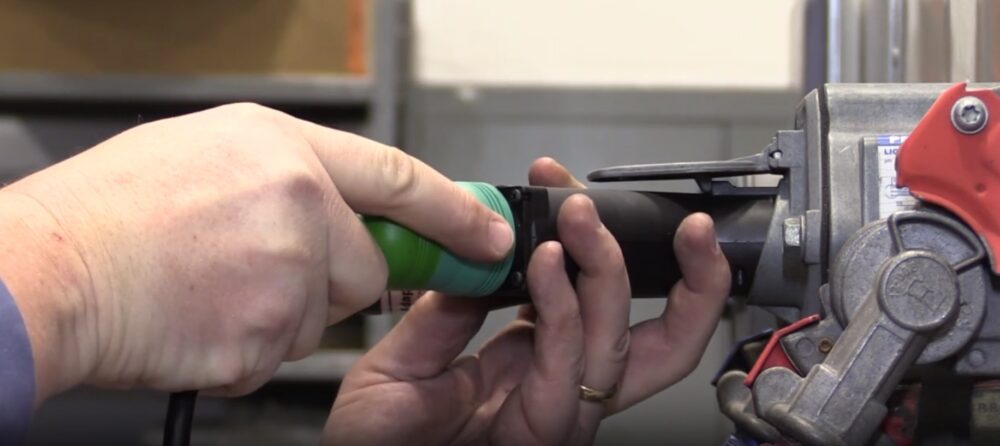As a follow-up to “Dusting Off Fuel System Fossils” in April’s edition of Underhood Service, I will share many driveability concerns and emissions failures that I’ve repaired by rebuilding, and sometimes modifying, certain carb circuits. But before diving into a carburetor rebuild or recalibration, be certain that you understand the system you’re working on, including operating strategies of the feedback system on vehicles with fuel mixture control solenoids.
Oh, the Things I’ve Seen…
When faced with an engine overheating concern, which component is at fault? That’s right – the root cause(s) are many and varied; defective thermostat, plugged radiator, inoperative fan switch, low coolant, ruptured head gasket, etc. The same is true for carbureted fuel systems. If you’re faced with a carbureted engine that has poor fuel mileage, a hesitation, a backfire or an emissions failure, don’t assume that the internal carb circuits are to blame. Always eliminate external causes for these symptoms before dissecting the carburetor.
For example, if a fuel pump fails on a fuel-injected vehicle, you’re faced with a no-start or a hesitation concern. The same can be true for the low-pressure, low-volume mechanical pumps. Even though there is a reserve of fuel in the float bowl, under high-load conditions, starvation can occur. Always perform suction, pressure and volume tests if you have a hesitation or a lean condition. The other items to keep in mind include:
Watch for “loaded” vapor canisters; these can introduce “unwanted fuel” into the engine.
Voltage drop issues. I have seen up to -2 volts on the O2 sensor wire because a non-factory replacement battery cable did not have a pigtail ground strap! This voltage drop across the O2 sensor sends CO through the roof.
Failed mixture control solenoids. These can be tested with an ohm meter and a dwell meter.
Procedures will vary, but proper dwell typically has the solenoid dithering in the middle of its range. Toyotas (and late-model Chevy Novas) with the electronic air bleed control valve (EBCV) mixture control system differ from most systems. As the name suggests, this system uses a richer-than-normal main metering circuit and bleeds air into the main circuit to control the air/fuel ratio.
Honda Accords use power-controlled frequency valves to meter fuel. If using a lab scope, “on” is high voltage. These can go to 100% duty cycle.
Filters on Toyota high-altitude compensators (HACs) can plug, skewing their ability to function. Also, watch for a “V” cut in the lowest hose of the HAC (some technicians’ way of compensating for a plugged HAC filter). If your Toyota vehicle has an “A” and a “B” vacuum switch, watch for swapped vacuum hoses.
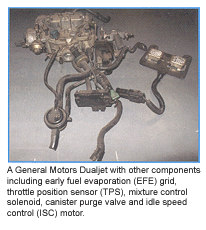
A properly functioning coolant temperature sensor. Systems won’t go into closed loop without it.
Reduce un-metered air by re-bushing the throttle shaft bores and replacing the throttle plates.
Perform a catalytic converter test. The oxygen absorption test is the first one that I learned, but the GM method seems to be preferred by most techs. Also, many catalytic converters become plugged from running rich. These can be replaced with low-cost, three-way aftermarket replacements.
Many feedback systems need to see a speed sensor signal to go into closed loop. The sensor may be in the speedo head, so guess what a broken speedo cable will do! Chrysler 2.2L engine control systems require this.
On General Motors vehicles, the canister purge valve has a high failure rate if it’s on the intake manifold. This can cause a gross rich condition.
Beware of an inoperative thermal vacuum valve (TVV) or incorrect vacuum hose routing for choke pull-offs or other diaphragms.
Check for air temperature sensors that were left unplugged, or plugged into an incorrect lead, after the air cleaner housing was reinstalled. This occurs frequently on Hondas.
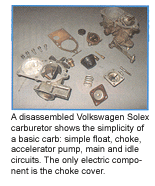
TPS adjustment is critical, especially on GMs, and can cause high CO failures. If out of adjustment, the computer receives a “wide open throttle” signal too soon, causing full enrichment and fixed timing.
The air injection system may have management valve failure. If air is diverted upstream with a hot engine, oxygen sensors can interpret this “false air” as true exhaust oxygen content and send a rich command to the mixture control solenoid Also, be sure the air injection systems are working correctly and that the air pump is producing enough volume. (O2 readings on your emissions analyzer should rise at least 2-3% when enabled). I’ve seen a lot of rusted or removed air injection manifolds and burned check valves, as well.
A closed signal from a throttle switch can result in fixed timing and fuel, so if this switch is shorted, driveability and emissions problems will result.
Many temperature switches are just switches, not negative temperature coefficient (NTC) thermistors. Coolant and charge temperature switches affect EGR enable, air switching from upstream to downstream, canister purge and fuel feedback status.
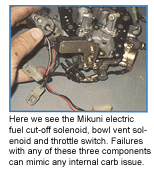
I’ve seen a fuel-injected 4-cylinder Chrysler system that needed to see “D” from the PRNDL before going into closed loop and fuel control. Read the enabling criteria for each system before condemning any parts!
Burned-through EGR plates that mount under the carb. (Can you say “hydrocarbons”?)
I’ve seen a bad distributor vacuum advance diaphragm cause low system vacuum and a rough-running engine on some systems. I’ve also seen a bad auxiliary accelerator pump (AAP) diaphragm on Toyota engines that will cause extremely rich-running engines. This diaphragm is used for cold enrichment, so if it is ruptured you’ll see a rich condition until the engine warms, unless the thermal vacuum switch (TVS) that controls the AAP is stuck open, then you’ll have a constantly rich-running engine!
PCV hoses will soften from exposure to oil, and collapse. Without this calibrated air entering the engine, the vehicles often run too rich.
Run-o-the Mill Rebuild
In my experience, the two most common causes for opening up a carb has been due to the engine that dies because it has a plugged idle circuit, or the engine that runs too rich, creating poor mileage or failed emissions reports. In these situations, the rebuild is usually straight-forward. The carb is removed, disassembled and cleaned. A kit is purchased that includes all of the gaskets, O-rings, check balls and the needle-and-seat assembly. A float is thrown in for good measure, and all choke pull-off diaphragms are tested for their ability to hold vacuum. The float is properly adjusted for drop and level, the accelerator pump diaphragm or seal is renewed, and the carb is assembled with new seals. Finally, the choke opening is adjusted to specs.
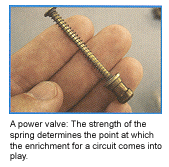 Have you ever done this, only to have the same concern after you performed the carburetor rebuild? Come on, admit it. I have. That is why I learned to scrutinize the internal carb parts, and locate the root cause for the concern.
Have you ever done this, only to have the same concern after you performed the carburetor rebuild? Come on, admit it. I have. That is why I learned to scrutinize the internal carb parts, and locate the root cause for the concern.
For example, on carbs that won’t idle due to a lean condition, I usually find a leaking carburetor base-plate gasket, a defective fuel cut-off solenoid or an internal air bleed jet that is plugged with mosquito guts. Sometimes I find a remote vacuum leak, such as a brake booster, that I overlooked.
On carbs that are running grossly rich – I mean the fuel is dumping out of the main venturi at idle – I usually find a hollow float that has filled with gas, or I find a needle-and-seat assembly that won’t shut the fuel off. This is the same condition as when you hear your toilet run water during the night, without stopping.
Some carburetors, such as Rochester Quadra-Jets, have leaking main fuel wells that will drip raw fuel into the intake manifold, even with the engine off. This is an example of a model-specific issue that can be hard to pinpoint without prior knowledge.
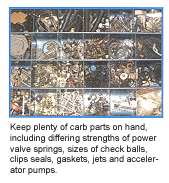 Note: Be cautious of “off-the-shelf” rebuilt carbs – you may have to re-set the float levels and adjust the power valve stops on many of these carbs before sending a customer on their way.
Note: Be cautious of “off-the-shelf” rebuilt carbs – you may have to re-set the float levels and adjust the power valve stops on many of these carbs before sending a customer on their way.
When a Normal Rebuild Just Won’t Do
Now I’d like to share some examples to illustrate the need to sometimes alter one or more of the carburetor’s internal circuits, in order to achieve the desired outcome. Alterations include changing jet sizes and the point at which the power valve begins to operate. As I discuss the following examples, remember that re-jetting should only be performed after all other systems on the vehicle have been evaluated and are in proper working order. This includes, but is not limited to: basic mechanical condition of the engine, basic engine adjustments, evaporative emissions systems, catalyst integrity, computer control systems and vacuum routing.
Toyota with High CO
Recently, a customer arrived at my door with a 1987 Toyota pickup truck and a failed emissions inspection report for high carbon monoxide (CO). She had been to other shops and spent a nice sum of money attempting to get her truck to pass “the test.” What I found while investigating this failure was surprising.
Before I ever opened the hood, I took the truck for a test drive to feel for misfires, watch for visible smoke, check for overheating and get an overall feel of the performance. This truck felt a little sluggish, and I could see a hint of black smoke coming from the exhaust on a hard acceleration.
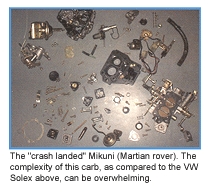 Back at my shop, I popped the hood and checked the VECI decal. Sure enough, it was a California-certified truck for use at low altitude. What does that mean to us here in Colorado at a mile in the sky? Plenty.
Back at my shop, I popped the hood and checked the VECI decal. Sure enough, it was a California-certified truck for use at low altitude. What does that mean to us here in Colorado at a mile in the sky? Plenty.
The first thing that caught my eye during the visual inspection was the corroded battery terminals. Since excessive voltage drop across the negative battery cable can cause the PCM to misinterpret the O2 sensor readings and force the mixture rich, I checked it and found 1.45 volts! Could this be causing the emissions failure? In some cars it might, but not in this case.
Before cleaning the cables or removing the air cleaner, I baselined the exhaust gas readings with my 4-gas analyzer. CO was 8.1% under load with 450 ppm HC, and around 10% CO2. I definitely had a rich engine here. Knowing the emissions repair history of some of these Toyotas, I removed the air cleaner to perform further visual checks. There was a “V” cut in the hose that connects the electronic bleed control valve (EBCV) to the carburetor. Why the cut? This application is somewhat unique in that it meters filtered ambient air into the intake manifold for air/fuel control. Another tech thought opening this up to outside air would create a lean condition.
These electronic and vacuum systems are subject to tampering and misconnection, so I also checked for correct vacuum routing and electrical connections, rubbed-through plastic vacuum lines and pellet gun BBs in the HAC hoses. Some of these vehicles also came equipped with a high-altitude compensation valve, which should be checked for function. The throttle/idle switch should also close at idle and open off idle.
My next step was to check the feedback control circuit for function while on a road test. The O2 sensor gave me a constant rich reading of 900 mV, but back at the shop the response and calibration tests proved the sensor was able to function properly. On the road test, I also found that the EBCV valve was fixed at 66%; the PCM was trying as hard as it could to lean out this carburetor, but to no avail. The CO failed at 43 grams per mile on a 30 gpm standard. I knew I had to cut my 8.0% CO readings at least in half to make this truck pass the test. I began looking for other sources of unwanted fuel, such as the canister purge system, contaminated engine oil or a leaking power valve. I finally determined that the engine could probably pass the emissions test at sea level, but, as we’ve experienced with many low altitude-certified vehicles, this carburetor would need to be re-jetted.
I removed the air horn from the carb and pulled out the main jet. It had a “111” on it, which meant it was about 0.044”. I grabbed my collection of jets and searched for a slightly smaller number. I found one that had a “104” on it, making it about a 0.041” jet. I decided – also through experience – this would bring my CO numbers down without compromising the performance of the truck. I installed my new jet and a new gasket, and then performed another loaded 4-gas test. My CO dropped to 3.1%, my HC went to 200 ppm, and my CO2 improved to 13%. I was satisfied that I’d found the root cause, but I went for another test drive with my lab scope hooked up to the O2 sensor wire. I found that the system was now in fuel control, and when you’re chasing after a failure like this, nothing makes you happier.
I drove the truck down to the emissions test facility for my customer’s free retest. Did the truck pass? It did; with a 5 gpm CO reading on a 30 gpm scale! The performance of the truck actually improved, and the hint of black smoke that was coming from the pipe on hard acceleration had disappeared.
General Motors 2.8L, Non-Feedback Varajet Carburetor
I recently worked on one of these carbs on a Canadian vehicle. This 1985 Olds Cutlass failed an enhanced emissions test at 105 gpm CO on a 30 gpm limit. This vehicle also had border papers that exempted it from EPA regulations, so it did not have air injection or a feedback carb! I road-tested the vehicle, baselined the in-stall exhaust readings, followed approved diagnostic procedures and recorded my findings. I recommended carburetor and timing adjustments, and a re-jetting procedure.
To make a long story short, after searching in vain for smaller jets from our suppliers, I reduced the size of the main metering jet by 0.007 – by filling with solder and re-drilling with a jet drill and a pin vice. I also replaced the spring under the power piston assembly, with a slightly softer version, to reduce power circuit enrichment. The car returned to the lanes and passed with a 14 gpm CO reading on a 30 gpm scale.
In addition, I’ve replaced the “180” jet found in low-altitude certified carbs with a “174” jet that I found in a high-altitude carb.
Opportunities
When you tackle a fuel-metering issue on a carbureted vehicle, you often have more possibilities to juggle than with a port-injected system. Rebuilding a 25-year-old carburetor to fix a flooding condition, a stalling issue, a dangerous hesitation or an emissions failure can be quite lucrative, and very satisfying. Don’t forget to research TSBs and extract knowledge from that one guy you know who “rebuilt those carbs back-in-the-day.”

